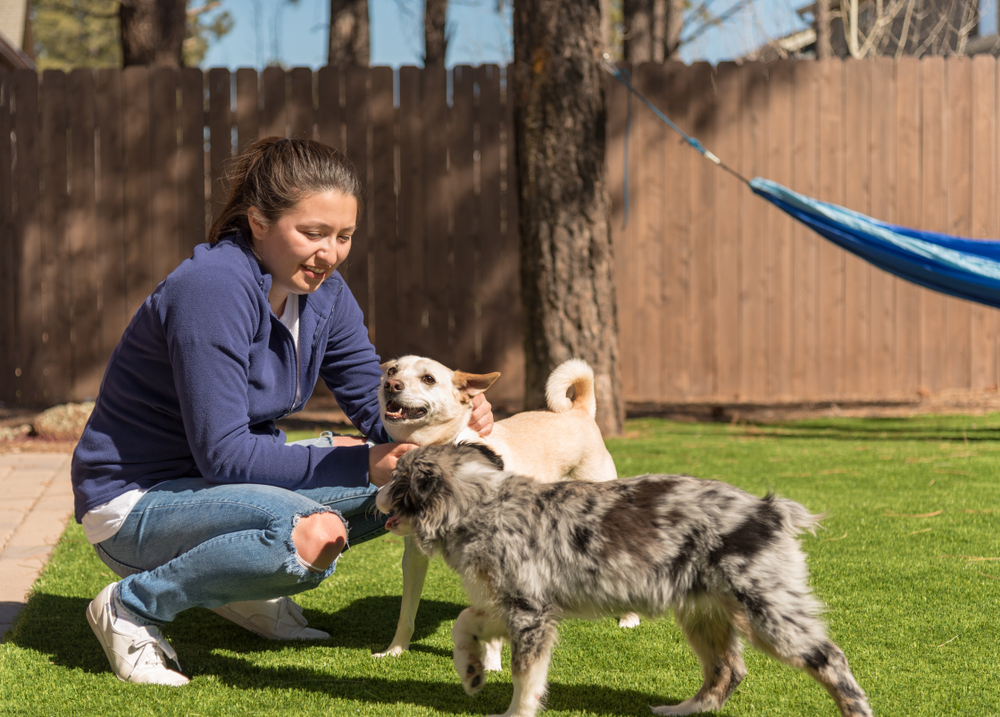The best outdoor spaces are designed with the same care as indoor spaces. As extensions of living areas, yards and gardens should be safe and enjoyable for all family members, including pets. Here’s how to create outdoor spaces that everyone can love.
Outdoor Access
Dogs usually have access to outdoor areas. What about cats? Experts agree that indoor cats should not roam freely because of dangers such as cars and predators. However, your cat can still have safe and enriching outdoor experiences. A catio is an indoor/outdoor space and can be anything from a screened porch to a fully fenced and covered outdoor space your cats can explore. This article provides some useful catio ideas.
Yard Layout and Design Features
Design becomes easy when you put yourself in the paws of your dogs! Begin with an open, grassy area to chase a ball and poop and pee. If your yard is small and grassy areas are easily destroyed, consider using faux grass. While artificial grass is practical, it is expensive to install correctly, and it gets hot, so it needs to be partially or fully shaded.
Follow these tips for a healthy, dog-safe yard:
- Enclose your vegetable garden with fencing. This will keep plants from being trampled and will keep dogs away from tomato plants (the leaves and stems are toxic to pets).
- Use raised planting beds to deter dogs from walking through shrubs.
- Provide other raised structures such as large, flat stones so your dog can jump up on something appropriate.
- Use only plastic or stone edging. Metal edging is notorious for cutting paws.
- Shredded mulch works best for mulched areas because it is not easily displaced and is soft to walk on.
- Pet-safe gravel is small with rounded edges. Larger stones or sharp gravel can hurt dogs’ feet.
- Provide some shady areas for your dogs and catio cats, as well as some areas of sun.
Select the Right Plants
The most important consideration for a pet safe yard is the type of plants that are incorporated. The best resource for selecting pet-friendly plants and avoiding toxic ones is a list compiled by the American Society for the Prevention Cruelty to Animals.
Here are some general guidelines for appropriate plants for pets:
- Grasses in containers are great for your catio. Wheat, barley, oats, and alfalfa are safe for cats, nourishing if consumed, and enriching for them to play with.
- Most (but not all) ornamental grasses are safe for pets and look nice in landscaping. They’re durable as well.
- Urine-resistant plants are practical. Generally, plants that are high nitrogen consumers (roses, garden vines such as cucumbers, squashes, melons) also are urine tolerant. Several attractive perennials such as Mexican Sage, which has a beautiful feathery texture and purple blossoms, are especially urine tolerant. Ask your local garden place about urine tolerance, and if they don’t know, ask about nitrogen needs for the plant.
- Include olfactory enriching plants for pets, such as honeysuckle vines, catnip, and herbs such as lavender, rosemary, thyme, oregano, and cilantro. Some annuals such as marigolds and petunias are also safe and fragrant.
Keep Your Yard Safe
Once you have planted your pet-safe yard, be sure to keep it healthy. Do not use pesticides at all. An exception might be made for a fire ant infestation or a nest of dangerous hornets, but in most other cases, pesticides can and should be avoided. Don’t use herbicides either. Herbicides have a variety of deleterious effects, including significantly higher risk of bladder cancer in dogs. Instead, hand weed in the spring and water carefully to keep plants healthy and weeds at bay.
Enjoy!
Knowing that you are keeping all family members well cared for is a great feeling. Make a place for yourself in the catio or the garden so you can relax with your pets and enjoy the outdoor living space you have created!
This article was reviewed/edited by board-certified veterinary behaviorist Dr. Kenneth Martin and/or veterinary technician specialist in behavior Debbie Martin, LVT.








